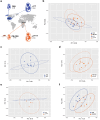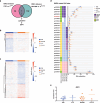Placental malaria induces a unique methylation profile associated with fetal growth restriction
- PMID: 40051167
- PMCID: PMC11901535
- DOI: 10.1080/15592294.2025.2475276
Placental malaria induces a unique methylation profile associated with fetal growth restriction
Abstract
Fetal growth restriction (FGR) is associated with perinatal death and adverse birth outcomes, as well as long-term complications, including increased childhood morbidity, abnormal neurodevelopment, and cardio-metabolic diseases in adulthood. Placental epigenetic reprogramming associated with FGR may mediate these long-term outcomes. Placental malaria (PM), characterized by sequestration of Plasmodium falciparum-infected erythrocytes in placental intervillous space, is the leading global cause of FGR, but its impact on placental epigenetics is unknown. We hypothesized that placental methylomic profiling would reveal common and distinct mechanistic pathways of non-malarial and PM-associated FGR. We analyzed placentas from a US cohort with no malaria exposure (n = 12) and a cohort from eastern Uganda, a region with a high prevalence of malaria (n = 12). From each site, 8 cases of FGR and 4 healthy controls were analyzed. PM was diagnosed by placental histopathology. We compared the methylation levels of over 850K CpGs of the placentas using Infinium MethylationEPIC v1 microarray. Non-malarial FGR was associated with 65 differentially methylated CpGs (DMCs), whereas PM-FGR was associated with 133 DMCs, compared to their corresponding controls without FGR. One DMC (cg16389901, located in the promoter region of BMP4) was commonly hypomethylated in both groups. We identified 522 DMCs between non-malarial FGR vs. PM-FGR placentas, independent of differing geographic location or cellular composition. Placentas with PM-associated FGR have distinct methylation profiles compared to placentas with non-malarial FGR, suggesting novel epigenetic reprogramming in response to malaria. Larger cohort studies are needed to determine the distinct long-term health outcomes in PM-associated FGR pregnancies.
Keywords: IUGR; Pregnancy; epigenetics; fetal growth restriction; fetal programming; malaria; placenta; plasmodium falciparum.
Conflict of interest statement
No potential conflict of interest was reported by the author(s).
Figures





Update of
-
Placental Malaria Induces a Unique Methylation Profile Associated with Fetal Growth Restriction.bioRxiv [Preprint]. 2024 Oct 4:2024.05.09.593431. doi: 10.1101/2024.05.09.593431. bioRxiv. 2024. Update in: Epigenetics. 2025 Dec;20(1):2475276. doi: 10.1080/15592294.2025.2475276. PMID: 38798500 Free PMC article. Updated. Preprint.
References
-
- Garrison A, Boivin MJ, Fiévet N, et al. The effects of malaria in pregnancy on neurocognitive development in children at 1 and 6 years of age in Benin: a prospective mother–child cohort. Clin Infect Dis Off Publ Infect Dis Soc Am. 2022. Mar 9;74(5):766–16. doi: 10.1093/cid/ciab569 - DOI - PMC - PubMed
-
- Bangirana P, Conroy AL, Opoka RO, et al. Effect of malaria and malaria chemoprevention regimens in pregnancy and childhood on neurodevelopmental and behavioral outcomes in children at 12, 24, and 36 months: a randomized clinical trial. Clin Infect Dis. 2023. Feb 18;76(4):600–608. doi: 10.1093/cid/ciac815 - DOI - PMC - PubMed
MeSH terms
Grants and funding
LinkOut - more resources
Full Text Sources
Other Literature Sources
Medical
Miscellaneous
